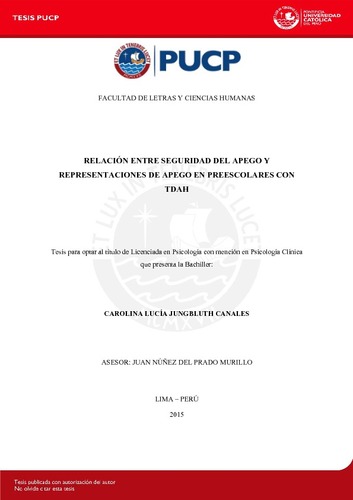| dc.contributor.advisor | Núñez del Prado Murillo, Juan | es_ES |
| dc.contributor.author | Jungbluth Canales, Carolina Lucía | es_ES |
| dc.date.accessioned | 2016-02-29T15:34:43Z | es_ES |
| dc.date.available | 2016-02-29T15:34:43Z | es_ES |
| dc.date.created | 2015 | es_ES |
| dc.date.issued | 2016-02-29 | es_ES |
| dc.identifier.uri | http://hdl.handle.net/20.500.12404/6533 | |
| dc.description.abstract | La presente investigación tiene como objetivo explorar la relación entre la seguridad del apego y las representaciones de apego en preescolares con rasgos de Trastorno por Déficit de Atención e
Hiperactividad. Para ello se evaluó a 12 niños con edades entre 4 y 6 años (M = 4.67, DE = .65) junto a sus madres, con edades entre 26 y 46 años (M= 38.5, DE=5.8). Para evaluar la seguridad del apego se utilizó el Attachment Q-Set 3.0 (Waters,1995) y para las representaciones de apego el Attachment Story Completion Task (Bretherton, Ridgway y Cassidy, 1990). Si bien no se encuentra una relación significativa entre los puntajes generales, se ha visto que existe una relación media y directa entre la narrativa Rodilla lastimada y la sub-escala Búsqueda de proximidad con la madre. Además, como objetivos específicos se buscó comparar la seguridad del apego y las representaciones de apego entre los niños con rasgos de TDAH y aquellos sin estas características, donde se encontró que no habían diferencias significativas. Por último se evaluó si existían diferencias en la seguridad del apego entre los niños con rasgos de TDAH cuyas madres reportaban tener ayuda en su cuidado y los que no. Así, se vio que los niños cuyas madres no cuentan con apoyo tienden a presentar una disposición emocional al momento de interactuar con ella y de seguir órdenes más alta. Estos resultados aportan al estudio del vínculo en los niños con TDAH y dan luces acerca de cómo las características del diagnóstico influyen en el establecimiento de un apego inseguro. | es_ES |
| dc.description.abstract | This research aims to explore the relantionship between attachment security and attachment representations in children with symptoms of ADHD. In order to acheve this, 24 children between the ages of 4 and 6 years (M = 4.67, DE = .65) were evaluated, as well as their mothers, whose age varied between 26 and 46 years (M= 38.5, DE=5.8). To evaluate that we used the Attachment Q-Set 3.0 (Waters,1995) and the Attachment Story Completion Task (Bretherton, Ridgway y Cassidy, 1990). We found there were not sifniticant relantion between the general constructs, but the study found a positive relation between the Hurt knee story and Proximity to mother. Additionally, the study had specific objetives of compare the attachment security and the attachment representations between preescholar children with ADHD and children without these symptoms, finding that there were any statistically significant differences between them. In addition, we compare the attachment security in children with symptoms of ADHD whose mothers reported to have support in nursing and those whose mothers didn’t have support. The study found that kids whose mothers had support had a better emotional disposition when interacting with their mothers and to follow instructions. These results contribute to the study of attachment in children with ADHD and shed light on how these symptoms affect the attachment development. | es_ES |
| dc.language.iso | spa | es_ES |
| dc.publisher | Pontificia Universidad Católica del Perú | es_ES |
| dc.rights | Atribución-NoComercial-SinDerivadas 2.5 Perú | * |
| dc.rights | info:eu-repo/semantics/openAccess | es_ES |
| dc.rights.uri | http://creativecommons.org/licenses/by-nc-nd/2.5/pe/ | * |
| dc.subject | Conducta de apego en los niños. | es_ES |
| dc.subject | Psicología infantil | es_ES |
| dc.subject | Trastorno por déficit de atención e hiperactividad. | es_ES |
| dc.title | Relación entre seguridad del apego y representaciones de apego en preescolares con TDAH | es_ES |
| dc.type | info:eu-repo/semantics/bachelorThesis | es_ES |
| thesis.degree.name | Licenciado en Psicología Clínica | es_ES |
| thesis.degree.level | Título Profesional | es_ES |
| thesis.degree.grantor | Pontificia Universidad Católica del Perú. Facultad de Letras y Ciencias Humanas. | es_ES |
| thesis.degree.discipline | Psicología Clínica. | es_ES |
| renati.discipline | 313026 | es_ES |
| renati.level | https://purl.org/pe-repo/renati/level#tituloProfesional | es_ES |
| renati.type | http://purl.org/pe-repo/renati/type#tesis | es_ES |
| dc.publisher.country | PE | es_ES |
| dc.subject.ocde | https://purl.org/pe-repo/ocde/ford#5.01.00 | es_ES |






